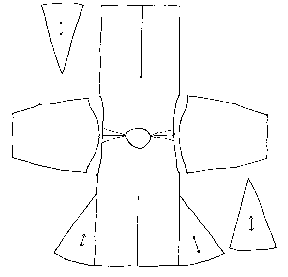Tunic
A type of Garb
Description;
The tunic is "standard" torso garb. It will almost always have sleeves and closed sides, unlike a Tabard which has open sides.
Tunics are sometimes called a 'Bell Tunics'. The 'Bell' refers to the belled shape of the bottom of the Tunic, This is created using triangle shaped gores or cutting the body of the Tunic with sides that slope outward. The garment it's self is pattered on a very large T-shirt.
Historical Finds
The garments of the fifth-century jarl buried at Evebø, Norway, are too fragmentary to determine the way they were made. The remains are mainly useful for what they reveal about tunic length, decoration, and layering. The two wool garments were found in situ with one worn over the other. The red undertunic had elaborate tablet-woven wool trim at the neck, wrists, and hem, with bronze wrist clasps; it came down as far as the knee. The overtunic had a different type of tablet-woven wool trim at the neck, plus silver clasps in some undetermined location (Magnus 1982, 68-69). Given the existence of the silver clasps, as well as the striking appearance of the undertunic, the overgarment may well have been some sort of a coat designed to augment, rather than cover, the undertunic; the clasps might have held it together on the chest.
The excavations at Birka, Sweden, which cover the ninth and tenth centuries, did not include entire garments. However, the pieces of clothing that were found there yielded quite a bit of information on different types of tunic-type garments, including smocks, tunics, and coats. There is plenty of evidence for linen smocks, wool tunics, wool and linen coats, and even one possibly Byzantine-style linen long tunic. Construction details common to them all include front and back panels cut in one piece, rather than two-piece construction with shoulder seams, and small round or keyhole necklines. Triangular gores were added for additional width in the skirt area of many garments. Unique to Birka is evidence for the woman's pleated smock from the tenth century; this style of undergarment would not have required gores for widening. Also unique to Birka is the men's sleeved "riding" coat closed on the chest with small cast bronze buttons running from neck to waist; it is thought to be influenced by Persian riding coats by way of Byzantium and the Rus lands. Some Birka women wore a similar overgarment, but instead of bronze buttons this coat was held together by a fancy brooch pinned through two small loops that were sewn to the two sides of the garment at the mid-chest. It is not known how long the women's coats were, but clearly if they were meant to be protective overgarments they would need to be rather long--and require more than one closure point in front!
Here below are suggested composite styles for a Birka tunic and coat. Note especially the dotted fold lines at the shoulders of both garments and the choice of two necklines offered on the drawing of the tunic garment.
Links
- How to from the beginners guide
